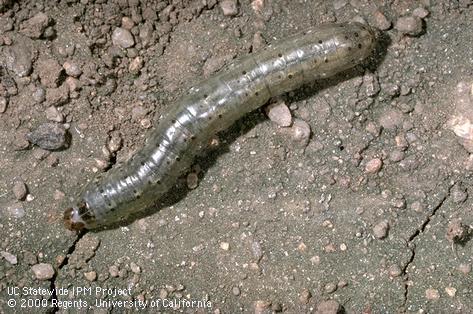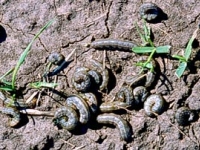


Cutworms
Forage crops frequently are attacked by several species of cutworms which may be divided into the following groups based on the feeding habits of the larvae.
1. subterranean cutworms. Members of this group feed almost entirely beneath the surface of the soil. The pale western cutworm, Agrotis orthogonia (Morr.), is a representative of this group and damages wheat and other small grains by severing the plant at or slightly above the crown. It passes the winter as a tiny larva within the egg shell. The worm emerges during early spring and feeds for a short time upon the leaves of the host plant but soon assumes the subterranean habit. There is only one generation annually.
2. Tunnel makers. These cutworms live in tunnels that open at the surface of the soil. The worm cuts off a plant, pulls it into its tunnel and usually devours the plant. An important member of the tunnel makers is the black cutworm, Agrotis ypsilon (Rott.), which attacks a wide variety of plants including corn, grain sorghum, clover, vetch, alfalfa and other legumes. There are several generations a year but probably the greatest damage is done by the first generation which usually occurs from April to June. Outbreaks frequently occur on "overflow land."
3. Surface feeders. These species of cutworms cut off small plants at or near the soil surface and may devour the fallen host plant. The worms are active mostly at night and hide in the soil or under surface trash during the day. Of the several species in this category, the army cutworm, Chorizagrotis auxiliaris (Grote), probably is the most important feeder on forage crops. This species attacks wheat and other small grain in North and Northwest Texas. The army cutworm may be active at temperatures slightly above freezing and frequently damages wheat and other small grain plants considerably during early spring. During cold weather the larva cuts off a plant tiller or leaf, pulls one end of it into the burrow and feeds on the plant. Grain fields attacked by this cutworm have the general appearance of having been grazed close to the soil surface. There is only one generation per year and the insect passes the winter as a larva in the soil or in debris affording it protection from extremely cold weather. Another species of surface-feeding cutworms occasionally of economic importance in forage is the granulate cutworm, Feltia subterranea (F.) Its primary range is Central and South Texas. Although vegetables are preferred, this cutworm also attacks alfalfa. The insect passes the winter in the pupal stage in the soil. There are three to five generations annually in the South.
4. Climbing cutworm. Included in this group are several kinds of cutworms that climb the host plant to feed on foliage, stems, leaves and fruit. Like other cutworms, they feed primarily at night and hide under debris and other objects during the day. Some species, however, feed during cool, cloudy days.
The variegated cutworm, Peridroma saucia (Hubn.), is the most important species of this group and feeds on legumes and, to some extent, on corn and other crops of the grass family. This worm commonly is referred to as the climbing cutworm. It frequently damages vetch severely. The mature larva is pale yellow or brown and is about 2 inches long. Well-marked characteristics are the presence of a row of four to six dull yellow or pink diamond shaped spots on its back and a crudely shaped black "W" on the top of the last abdominal segment. In most parts of Texas the insect survives the winter in the larval stage. The number of generations vary, but most of the damage is caused by a generation that occurs during the April-June period.